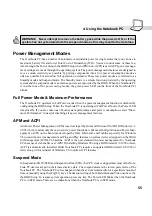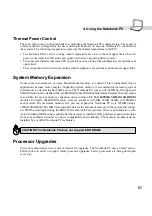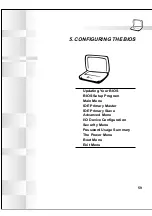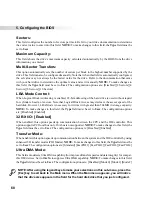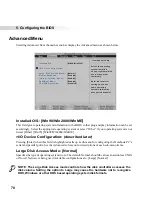
55
4. Using the Notebook PC
Power Management Modes
The Notebook PC has a number of automatic or adjustable power saving features that you can use to
maximize battery life and lower Total Cost of Ownership (TCO). You can control some of these fea-
tures through the Power menu in the BIOS Setup when APM (non-ACPI) is used. ACPI power manage-
ment settings are made through the operating system. The power management features are designed to
save as much electricity as possible by putting components into a low power consumption mode as
often as possible but also allow full operation on demand. These low power modes are referred to as
Standby mode and Suspend mode. The Standby mode is a simple function provided by the operating
system and the suspend mode is an intense power saver provided by the BIOS. When the Notebook PC
is in either one of the power saving modes, the green power LED (on the front of the Notebook PC)
blinks.
Full Power Mode & Maximum Performance
The Notebook PC operates in Full Power mode when the power management function is disabled by
configuring the BIOS Setup. When the Notebook PC is operating in Full Power Mode, the Power LED
remains ON. If you are conscious of both system performance and power consumption, select “Maxi-
mum Performance” instead of disabling all power management features.
APM and ACPI
Advanced Power Management (APM) was developed by Intel and Microsoft for DOS/Windows 3.1/
95/98 which controls only the main system power functions. Advanced Configuration and Power Man-
agement (ACPI) on the hand was developed by Intel, Microsoft, and Toshiba especially for Windows
98 to control power management and Plug and Play features on system devices designed on the Wired
for Management (WfM) 2.0 baseline. ACPI is the new standard in power management for Notebook
PCs because of its benefits over APM. If installing Windows 98 using a BIOS dated 12/1/1999 or later,
ACPI is automatically installed. Older Notebook PCs requires an updated BIOS (dated 12/1/1999 or
later) along with a reinstall of Windows 98 to utilize ACPI features.
Suspend Mode
In Suspend-to-RAM (STR) and Suspend-to-Disk (STD), the CPU clock is stopped and most of the Note-
book PC devices are put in their lowest active state. The suspend mode is the lowest power state of the
Notebook PC. The Notebook PC enters Suspend when the system remains idle for a specified amount of
time or manually using the [Fn][F1] keys. The timeout setting of both Hard Disk and Video can be set by
the BIOS Setup. To resume system operation, press any key. The Power LED blinks when the Notebook
PC is in STR mode. There are no indications when the Notebook PC is in STD mode.
WARNING! Never attempt to remove the battery pack while the power is ON, or if the
system has not yet entered into the suspend mode as this may result in the data loss.
Summary of Contents for S82A
Page 5: ...5 CTR 21 Approval for Notebook PC with built in Modem Italian Portuguese Spanish Swedish ...
Page 13: ...13 Top Side Front Side Left Side Right Side Rear Side 2 KNOWING THE PARTS ...
Page 81: ...81 APPENDIX Internal Modem Compliancy Glossary Index Owner Information ...
Page 84: ...84 Appendix ...
Page 91: ...91 Appendix ...















